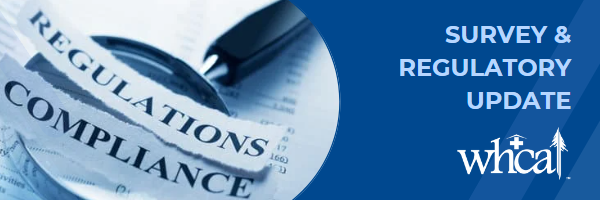Aug 22 2023 | Dining and Food Service-Phase 3 Requirements of Participation
The Centers for Medicare & Medicaid Services (CMS) made changes and clarifications to the food service and dining requirements in the Phase 3 implementation of the Requirements of Participation (ROP) effective November 2022. A number of these additions/clarifications are found in F812. While it’s important to read and process these requirements in their entirety, a synopsis of the changes is below:
In the F-tag, CMS separated the definitions of food distribution and food service operations, these were previously grouped together.
• The definition of food distribution was clarified to by stating, “When meals are assembled in the kitchen and then delivered to residents’ rooms or dining areas to be distributed, covering foods is appropriate, either individually or in a mobile food cart.”
• CMS added a new definition for food service, which states “Food Service means the processes involved in actively serving food to the resident. When actively serving residents in a dining room or outside a resident’s room where trained staff are serving food and beverage choices directly from a mobile food cart or steam table, there is no need for food to be covered. However, food should be covered when traveling a distance (i.e., down a hallway, to a different unit or floor).”
The CMS guidance highlights that unsafe food handling practices “represent a potential source of pathogen exposure for residents and sanitary conditions must be present in health care food service settings to promote safe food handling.”
• Clarification was made to the section on hair restraints, jewelry, and nail polish. CMS added details on when staff must wear hair restraints. Hair restraints must be worn when cooking, preparing, or assembling food, such as stirring pots or assembling the ingredients of a salad. No hairnets needed when distributing foods to residents at the dining table(s) or when assisting residents to dine.
• Clarification was also added regarding when staff glove use is necessary. CMS specifically calls out that gloves are to be used by all staff when touching ready‐to‐eat foods or when serving residents who are on transmission‐based precautions.Staff do not need to wear gloves when distributing foods to residents at the dining table(s) or when assisting residents to dine, unless touching ready-to-eat food.
• Changes made to the F-tag regarding food distribution included CMS adding the statement regarding systems for distributing food that mobile food carts must“maintain food in the proper temperature and out of the danger zone” as well as highlighting the fact that “timely distribution is essential to ensure food and beverages are served at the proper temperature”.
• CMS referenced that dining locations include any area where one or more residents eat their meals. These can be located adjacent to the kitchen or a distance from the kitchen, such as residents’ rooms and dining rooms on other floors or areas of the building.
• CMS noted that food preparation and service area compliance problems may include staff distributing meals without first properly washing their hands and serving food to residents after collecting soiled plates and food waste without proper hand washing.
Further clarification made to F 801 include requirements when a qualified dietitian or other clinically qualified nutrition professional is not employed full-time. The facility must designate a person to serve as the director of food and nutrition services. More information regarding thisand the state requirements for a Certified Food Protection Manager can be found in this previously published WHCA Survey & Regulatory Update.
CMS made minimal changes to the Kitchen/Food Service Critical Element Pathway (CEP). The red highlighted sections are reflective of the new guidance as it relates to hair restraints, sanitary conditions, and prevention of food borne illnesses. They also included labeling and dating food items in the refrigerator.
The Dining Critical Element Pathway has also been updated with the new requirements outlined above. The red highlighted sections are reflective of the new guidance as it relates to hair restraints, sanitary conditions, prevention of communicable diseases and infections. There is a component related to residents being served upon arrival if they are all seated at the same time.
To ensure your facility is in compliance with these requirements, some things to audit are as follows:
❑ Examine current policies and/or procedures to ensure
❑ Food is covered when required.
❑ Hair restraints are worn when required: cooking, preparing, or assembling food, such as stirring pots or assembling the ingredients of a salad.
❑ Staff are wearing gloves when necessary to include when touching ready‐to‐eat foods or when serving residents who are on transmission‐based precautions.
❑ Staff are washing their hands when staff are distributing meals and serving food to residents after collecting soiled plates and food waste.
❑ Train/educate staff on proper food and nutrition preparation.
If you have questions regarding the SNF requirements, please contact Elena Madrid or call at (800) 562-6170, extension 105.
Posted in Skilled Nursing Facilities, Survey & Regulatory

